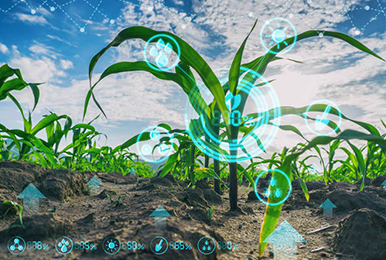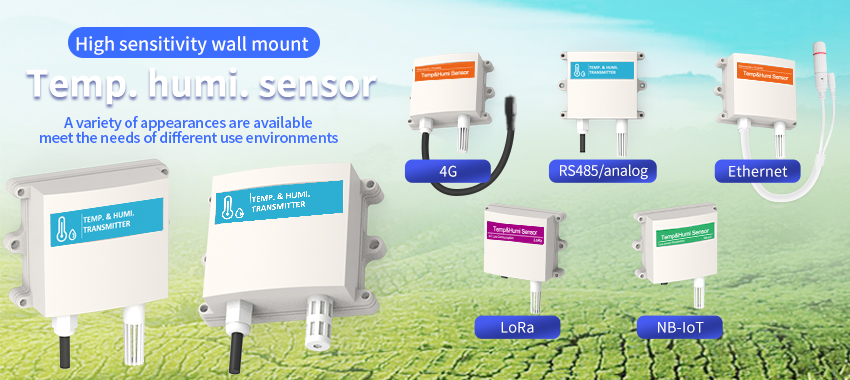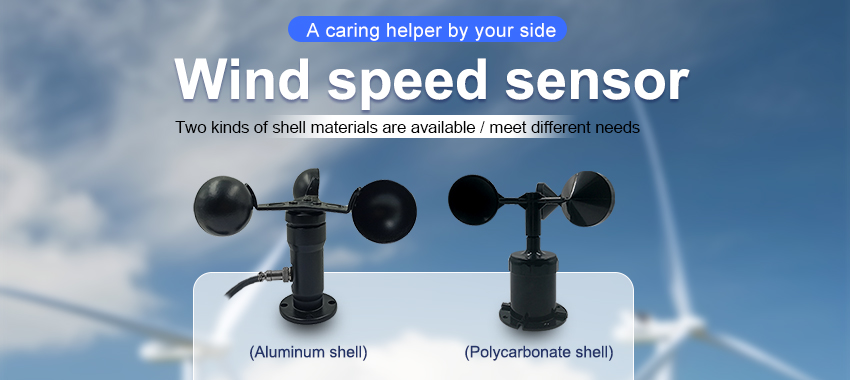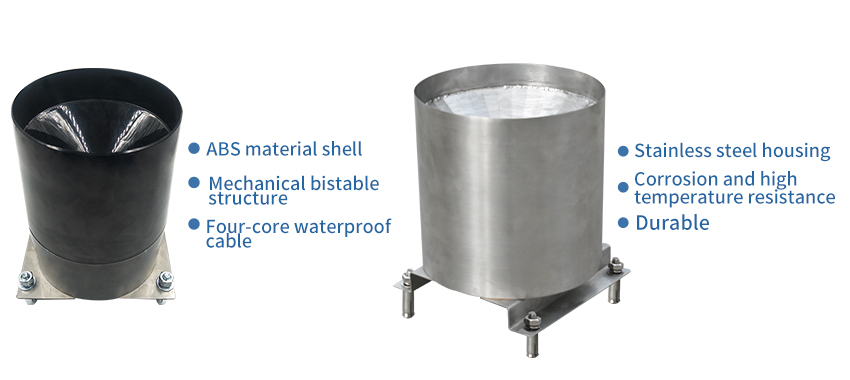Background:
The main purpose of environmental monitoring is to provide data on environmental quality and trends in order to ensure the safety of public life and property. The degree of pollution and environmental quality can be judged by monitoring and analyzing various environmental indicators. The scope of environmental monitoring involves air, temperature, humidity, soil and other types. Sensors are one of the most important tools, and environmental sensors are one of the key components commonly used in iot design.

What is an environmental sensor?
Environmental sensors are a series of sensors that monitor the environment and identify environmental quality. Environment sensors include soil sensors, temperature and humidity sensors, gas sensors, rain sensors, light sensors, and wind speed and direction sensors. Not only can you accurately measure environmental information, but you can also test, record, and store data
What types of environmental sensors are there?
Because of the different places of environmental monitoring, the kinds of environmental sensors are varied. Accuracy, sensitivity, and price are all factors to consider when choosing an environmental sensor. To help you choose the right environmental sensor, we have divided the environmental sensors into the following 10 types according to the different measuring elements.
1.Temperature and humidity
Temperature and humidity monitoring is the most basic component of environmental sensor. Temperature and humidity in the environment not only affect agricultural production and animal husbandry, but are also important for human health. If the temperature and humidity in the environment are too high or too low, it will affect our body to some extent. The cells of the human body can be active only if they are kept within a reasonable range. The temperature and humidity sensor can be used to measure the temperature and humidity in the environment. Here are some temperature and humidity sensors we recommend for you.
The main purpose of environmental monitoring is to provide data on environmental quality and trends in order to ensure the safety of public life and property. The degree of pollution and environmental quality can be judged by monitoring and analyzing various environmental indicators. The scope of environmental monitoring involves air, temperature, humidity, soil and other types. Sensors are one of the most important tools, and environmental sensors are one of the key components commonly used in iot design.
For indoor temperature and humidity monitoring, wall-mounted temperature and humidity sensors are usually used. The sensor occupies small space, has good ventilation and accurate measurement data. Long-term monitoring without maintenance. For outdoor environment monitoring, you are advised to use the sun shield temperature and humidity sensor because it has high protection grade and is resistant to rain and snow erosion. Works well even in windy weather and is perfect for use in fields and farms. After installation, data can be viewed remotely in real time, which is convenient for farmers to manage in time.

2.Air quality
Air quality is the most important part of environmental sensors. Air quality measurement of suspended fine particulate matter, mainly refers to PM2.5, PM10, formaldehyde, TVOC and other harmful substances, as well as carbon dioxide, negative oxygen ions. It leads to chronic diseases, such as leukemia caused by excessive formaldehyde and lung disease caused by excessive PM2.5. Therefore, it is necessary to use air quality sensors to monitor indoor and outdoor pollutant concentrations. Maintaining good air quality can prevent or reduce the occurrence of diseases. After all, prevention is much cheaper than cure. Here are some common air quality sensors.
Wall-mounted air quality sensors are often used in dust-heavy industries and are favored in harsh environments because of their excellent waterproof and dust-proof enclosures. Negative oxygen ion detector can simultaneously measure negative oxygen ions, formaldehyde, PM, CO2, temperature and humidity, etc., can be used in scenic spots, indoor and other places with high air quality requirements. In general, measuring air quality requires monitoring multiple pollutants. It is recommended that you use multi-functional AQI sensor, which can monitor 11 air quality elements at the same time, making it convenient and efficient.
3.The atmosphere
Environmental sensors are included to measure atmospheric pressure, sunlight, and noise. All three are also components of environmental monitoring. Atmospheric pressure is closely related to weather. Generally speaking, areas with high surface pressure tend to have sunny days, while areas with low surface pressure tend to have cloudy and rainy days. Monitoring atmospheric pressure can predict future weather.
Light is the premise of plant photosynthesis and affects plant growth and development, so monitoring light is beneficial to agricultural production. Installing light sensors on farms is one option for smart farming.
Environmental noise is divided into industrial noise, traffic noise, construction noise and living noise. Industrial noise may come from the operation of machines, the impact of mechanical components and friction. Traffic noise includes railway, aviation and ocean noise. Construction noise includes four construction stages: earthwork, pile driving, structure and decoration. In addition, the noise generated by commercial and entertainment places is the noise of social life. Noise can damage human hearing, and long-term exposure to noise pollution can cause mental breakdown. Therefore, long pole noise monitoring can be installed outdoors, and wall-mounted noise can be used indoors.
4.Soil
Soil monitoring is the most popular environmental sensor in recent years. Soil sensors are generally used to measure factors such as temperature, moisture, electrical conductivity, nitrogen, phosphorus, potassium and pH that affect crop growth. Both smart agriculture and smart irrigation require soil sensors as front-end measurement units to upload data from different locations to the monitoring platform for storage, analysis and scientific management.

5.Wind speed and direction
Monitoring wind speed and direction through environmental sensors is used to reflect meteorological information. In modern agriculture, wind sensors are used to measure wind speed and direction, analyze meteorological changes, give timely warning, and provide farmers with sufficient time to strengthen protection against meteorological disasters. In addition, pollutants in the atmosphere vary with wind speed and direction. The influence of wind on air pollution includes wind direction and speed. In general, wind direction affects the direction in which pollutants disperse. Pollutants are always transported downwind and contaminated areas are concentrated downwind. Wind speed determines how strongly air pollution spreads and how far it travels. The higher the wind speed.
Two types of wind sensors, mechanical and ultrasonic. Wind direction sensors are independent measuring units that can be used alone or in combination and are commonly used in agriculture and weather stations. Ultrasonic wind speed sensor is a set of wind speed and wind direction measurement in one of the equipment, can not be measured separately, often used in transportation and other fields.

6.Rain
Environmental sensors monitor rainfall by considering two factors: rainfall and evaporation. Excessive rainfall is prone to flooding, which not only pollutes water resources, but also causes solid waste pollution. Damage farmland ecosystem, harm people’s living environment. Excessive evaporation can easily lead to drought. Drought affects not only agriculture, but also industrial production, urban water supply and the ecological environment. The lack of water for plants leads to mass death and breaks the food chain.
The tipper rain gauge is the most commonly used unit of rain measurement. High precision, high reference value of data, conducive to meteorological and ecological research. Usually used in conjunction with evaporation sensors.
7.Radiation
Environmental sensors are needed to measure radiation intensity. Solar radiation, photosynthetically active radiation and ultraviolet radiation all affect the meteorological environment. Generally speaking, solar radiation will affect the development and change of most things on earth, so it is necessary to measure solar radiation in many fields. Measuring solar radiation in utilities can predict energy use, such as natural gas and electricity. In agriculture, plant yields can be studied and predicted. It can be used to predict weather changes. Similarly, the intensity of ultraviolet light will also affect the growth of plants and animals. Excessive ultraviolet light will kill many organisms in the natural environment, and will harm human and biological health, thus affecting biodiversity and ecological balance.
Solar radiation sensor is the most effective tool to monitor the total solar radiation intensity in the environment, measuring the spectral range of 0.3~3μm. If placed horizontally down, the reflected radiation can be measured, and the scattered mask ring can be measured. PAR sensors are mainly used to measure photosynthetically active radiation from natural light in the wavelength range of 400 to 700nm. Photosynthetically active radiation is an energy source for plant life activities, organic matter synthesis and yield formation. An ultraviolet sensor is a device that uses a photosensitive element to convert ultraviolet signals into electrical signals. Usually used in conjunction with other weather sensors.
8.Gas
Various gases are monitored through environmental sensors. There are many kinds of gases in the atmosphere, and the change of gas concentration will cause environmental changes. For example, a high concentration of carbon dioxide in the atmosphere can cause the greenhouse effect, a high concentration of ozone can affect plant photosynthesis and human health, and a high concentration of sulfur dioxide can seriously affect air quality. Therefore, it is necessary to monitor the concentration of various gases with the help of gas sensors. It is helpful for professionals to take timely measures.
Common gas sensors include CO2 sensor, CO sensor, CH4 sensor, NH3 sensor, O3 sensor, SO2 sensor, NO2 sensor, H2S sensor, and HCHO sensor. There are gas sensors that are installed in fixed locations for long-term monitoring, and gas sensors that can be held and monitored from anywhere. In some flammable and explosive places, explosion-proof gas sensors will generally be installed
9.Water level and pressure
Measuring the pressure and liquid level in the water can effectively analyze the changes in rivers, lakes and oceans to prevent drought and flood disasters. Water pressure and liquid level are also important basis for Marine experts to study Marine biological activities.
10.The water quality
Up to 70 percent of the earth we live on is water, and plants and animals cannot grow without water. Therefore, water pollution monitoring is the basis of environmental monitoring. A complete environmental sensor cannot be separated from water quality monitoring. Pollution was reflected by measuring PH, EC, DO, residual chlorine, turbidity, etc. If you have any questions about the choice of water quality sensor, please feel free to contact JXCT.